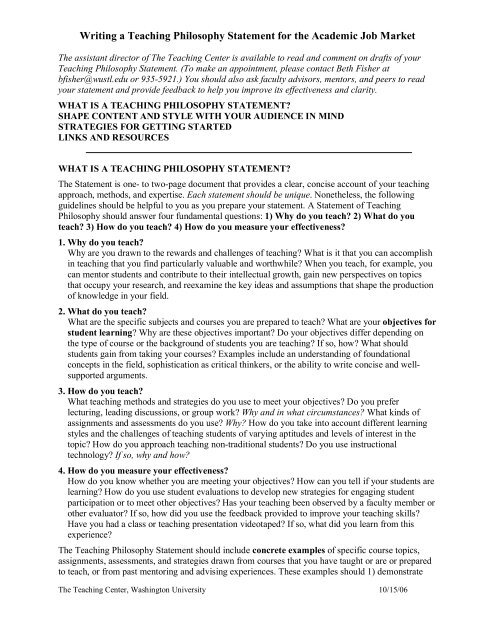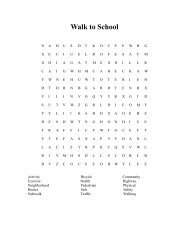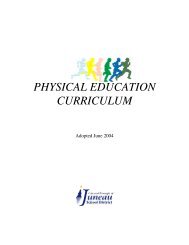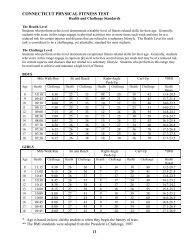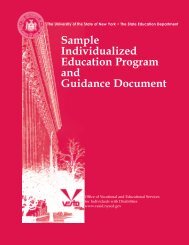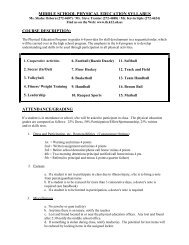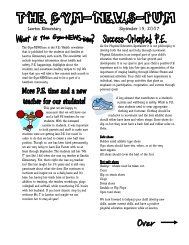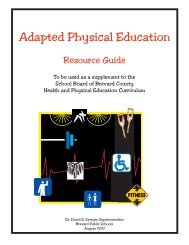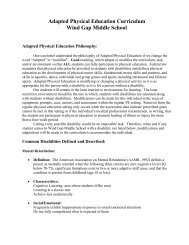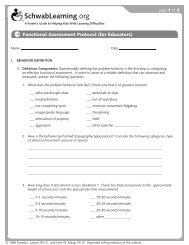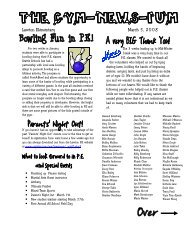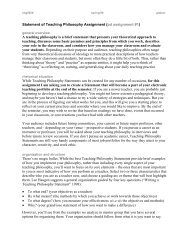writing a phil statement.pdf - thenewPE
writing a phil statement.pdf - thenewPE
writing a phil statement.pdf - thenewPE
You also want an ePaper? Increase the reach of your titles
YUMPU automatically turns print PDFs into web optimized ePapers that Google loves.
Writing a Teaching Philosophy Statement for the Academic Job Market<br />
The assistant director of The Teaching Center is available to read and comment on drafts of your<br />
Teaching Philosophy Statement. (To make an appointment, please contact Beth Fisher at<br />
bfisher@wustl.edu or 9355921.) You should also ask faculty advisors, mentors, and peers to read<br />
your <strong>statement</strong> and provide feedback to help you improve its effectiveness and clarity.<br />
WHAT IS A TEACHING PHILOSOPHY STATEMENT<br />
SHAPE CONTENT AND STYLE WITH YOUR AUDIENCE IN MIND<br />
STRATEGIES FOR GETTING STARTED<br />
LINKS AND RESOURCES<br />
WHAT IS A TEACHING PHILOSOPHY STATEMENT<br />
The Statement is one to twopage document that provides a clear, concise account of your teaching<br />
approach, methods, and expertise. Each <strong>statement</strong> should be unique. Nonetheless, the following<br />
guidelines should be helpful to you as you prepare your <strong>statement</strong>. A Statement of Teaching<br />
Philosophy should answer four fundamental questions: 1) Why do you teach 2) What do you<br />
teach 3) How do you teach 4) How do you measure your effectiveness<br />
1. Why do you teach<br />
Why are you drawn to the rewards and challenges of teaching What is it that you can accomplish<br />
in teaching that you find particularly valuable and worthwhile When you teach, for example, you<br />
can mentor students and contribute to their intellectual growth, gain new perspectives on topics<br />
that occupy your research, and reexamine the key ideas and assumptions that shape the production<br />
of knowledge in your field.<br />
2. What do you teach<br />
What are the specific subjects and courses you are prepared to teach What are your objectives for<br />
student learning Why are these objectives important Do your objectives differ depending on<br />
the type of course or the background of students you are teaching If so, how What should<br />
students gain from taking your courses Examples include an understanding of foundational<br />
concepts in the field, sophistication as critical thinkers, or the ability to write concise and wellsupported<br />
arguments.<br />
3. How do you teach<br />
What teaching methods and strategies do you use to meet your objectives Do you prefer<br />
lecturing, leading discussions, or group work Why and in what circumstances What kinds of<br />
assignments and assessments do you use Why How do you take into account different learning<br />
styles and the challenges of teaching students of varying aptitudes and levels of interest in the<br />
topic How do you approach teaching nontraditional students Do you use instructional<br />
technology If so, why and how<br />
4. How do you measure your effectiveness<br />
How do you know whether you are meeting your objectives How can you tell if your students are<br />
learning How do you use student evaluations to develop new strategies for engaging student<br />
participation or to meet other objectives Has your teaching been observed by a faculty member or<br />
other evaluator If so, how did you use the feedback provided to improve your teaching skills<br />
Have you had a class or teaching presentation videotaped If so, what did you learn from this<br />
experience<br />
The Teaching Philosophy Statement should include concrete examples of specific course topics,<br />
assignments, assessments, and strategies drawn from courses that you have taught or are or prepared<br />
to teach, or from past mentoring and advising experiences. These examples should 1) demonstrate<br />
The Teaching Center, Washington University 10/15/06
the range of your teaching expertise and 2) illustrate your objectives, methods, and approaches.<br />
Compiling a Teaching Portfolio will allow you to flesh out these examples by collecting<br />
“supporting documents” such as syllabi, actual assignments, exams, evaluations, and graded student<br />
papers. See “Preparing a Teaching Portfolio.”<br />
SHAPE CONTENT AND STYLE WITH YOUR AUDIENCE IN MIND<br />
When you write your teaching <strong>phil</strong>osophy <strong>statement</strong>, try to anticipate questions that a search<br />
committee would want your <strong>statement</strong> to answer. Ask your faculty mentors and graduate students<br />
who have interviewed for academic positions what they think search committees are looking for;<br />
these individuals are your best sources for learning about the expectations and issues that are<br />
particular to your field. Consult the Web site of the school to which you are applying to get a sense of<br />
the school’s mission and students, and the relative importance of teaching and research within the<br />
institution and the department.<br />
Here is a list of potential questions that may be motivating search committees when they ask you to<br />
submit a <strong>statement</strong> of teaching <strong>phil</strong>osophy:<br />
1. Will this candidate be able to handle the teaching responsibilities of the job<br />
2. Does her approach to teaching suggest that she would be a good “fit” for our department and<br />
our students<br />
3. Does this candidate want to teach If so, why<br />
4. If I were to step into a classroom and observe this candidate teaching, what would I see<br />
5. What are the objectives that shape this candidate’s approach to teaching and mentoring<br />
students What are the specific teaching methods that he uses to try to meet those objectives<br />
How does he measure his effectiveness<br />
6. How do this candidate’s research interests shape her teaching<br />
7. What will this candidate add to our department What will our students gain from his classes<br />
What will our department gain in terms of specific courses, new opportunities for students to<br />
develop their skills and knowledge, and interesting pedagogical approaches<br />
8. How does this candidate respond to the perennial challenges of teaching, such as motivating<br />
students to learn, evaluating student work, maintaining high standards in the classroom, and<br />
juggling teaching with other responsibilities we expect faculty to fulfill<br />
The Teaching Philosophy Statement is NOT a summary of the experiences on your CV, nor is it an<br />
article on pedagogy. It is a concise, specific discussion of the objectives and approaches you<br />
currently use, have used in the past, and plan to use in the future. Keep in mind that search<br />
committees are looking for colleagues. Reviewing in detail your past experience as a Teaching<br />
Assistant, without discussing specific methods or approaches you have developed and used in the<br />
classroom, may create an image of you as a student instead of a colleague.<br />
Formatting Conventions<br />
Limit the length of the final draft to between one and two pages. Again, consider your audience.<br />
Steering committees are buried in paper. The more concise your <strong>statement</strong> can be, the more likely<br />
The Teaching Center, Washington University 10/15/06
that the members of the committee will read it. A <strong>statement</strong> submitted for a position at a liberal arts<br />
college might be longer and more detailed than a <strong>statement</strong> that you submit for a position at a<br />
research university.<br />
Use the first person and, wherever possible, the present tense. The exceptions to the latter are the<br />
instances in which you are describing what you have done in courses taught in the past and what you<br />
will do in courses planned for the future. Avoid technical jargon. Your <strong>statement</strong> may be read by<br />
evaluators representing different disciplines and specializations. One of the hallmarks of effective<br />
teaching is the ability to explain concepts to audiences who are not experts in the field.<br />
STRATEGIES FOR GETTING STARTED<br />
Writing an effective Teaching Philosophy Statement can be a daunting task. Think of the process as a<br />
<strong>writing</strong> project and give yourself some time to explore ideas and try out different ways of expressing<br />
those ideas before you write the first draft of the <strong>statement</strong>. Here are some strategies for more<br />
informal, preliminary <strong>writing</strong> exercises on the topic of teaching:<br />
1. Write a letter to a friend or relative on the joys and challenges of teaching.<br />
2. Make a list of the qualities of an effective teacher.<br />
3. “Freewrite” on a memorable experience in the classroom that you experienced or observed.<br />
Consider what went well, what you might do differently, and why.<br />
4. Develop your “dream course.”<br />
v What would be your topic<br />
v What would you want to achieve in terms of helping students learn<br />
v How would you try to achieve those objectives<br />
v How would your research interests inform your approach<br />
5. Imagine yourself in your first academic position.<br />
v How will you teach an introductory, undergraduate course in your field<br />
v How will you organize a graduatelevel seminar<br />
v How will your research inform your approach in each case<br />
6. Begin with concrete details.<br />
v What sets you apart as a teacher<br />
v How would an observer describe your teaching<br />
v What are the specific skills and knowledge that students should gain in the classroom<br />
v What should happen in the classroom Why<br />
v What are the teaching methods that you consider most effective Why<br />
The Teaching Center, Washington University 10/15/06
LINKS AND RESOURCES<br />
Sample Statements<br />
You can find Teaching Philosophy Statements on various Web sites, including the University of<br />
Georgia site listed below. CAVEAT: These examples are not presented here as ideal models in terms<br />
of either content or <strong>writing</strong> style. Not surprisingly, some are more effective than others. However,<br />
reviewing these Statements will give you a good idea of the various ways in which others have<br />
approached this <strong>writing</strong> project. You should strive to create a Teaching Philosophy Statement that is<br />
unique and truly reflective of your own approach to teaching.<br />
“TA Mentors’ Teaching Philosophy Statements.” The Center for Teaching and Learning. The<br />
University of Georgia. <br />
Additional Links and Resources<br />
“Frequently Asked Questions about the Philosophy of Teaching Statement.” Office of Instructional<br />
Consultation. University of California, Santa Barbara. .<br />
Haugen, Lee. “Writing a Teaching Philosophy Statement.” Center for Teaching Effectiveness. Iowa<br />
State University. .<br />
Montell, Gabriela. “How to Write a Statement of Teaching Philosophy.” The Chronicle of Higher<br />
Education. March 27, 2003. .<br />
Montell, Gabriela. “What’s your Philosophy on Teaching, and Does it Matter” The Chronicle of<br />
Higher Education. March 27, 2003. <<br />
http://chronicle.com/jobs/news/2003/03/2003032701c/careers.html>.<br />
“Stating your Teaching Philosophy.” Center for Excellence in Teaching. University of Southern<br />
California. .<br />
“TiPPS For Philosophy of Teaching Statements.” Second Language Teaching and Curriculum<br />
Center. University of Hawaii at Monoa. <<br />
http://www.lll.hawaii.edu/sltcc/tipps/<strong>phil</strong>osophy.html>.<br />
Van Note Chism, Nancy. “Developing a Philosophy of Teaching Statement.” Ohio State University.<br />
.<br />
The Teaching Center, Washington University 10/15/06


